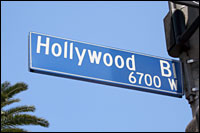
Whenever a Hollywood star steps behind a podium in support of a cause, you can almost hear the sound of millions of Americans rolling their eyes. What right, goes the thinking, do actors/pop stars/celebutantes have to tell us, the workaday citizens of the real world, what we should and should not believe about the political issue du jour?
Still, take a look at any newsstand or turn on any cable news channel and you can’t help but be awed by the sheer eyeball-captivating power of the Star Squad. Call it the marketing equivalent of solar energy — the entertainment industry is both the most abundant source of behavior-changing power out there and the most difficult to harness, at least in the service of something more meaningful than selling a logo-embossed handbag.
So how can the environmental movement best capture some of that power? Ever since attending “Location, Location, Location,” a panel discussion on the greening of Hollywood at the Santa Barbara Film Festival, I’ve been pondering that very question. So far, I’ve come up with three major areas where I believe the talents of the entertainment industry can help the green movement gain a little more momentum:
1. Science-to-human translations. When it comes to climate change, there is no obvious smoking gun — no nasty smell, no layer of toxic sludge in the basement, no overwhelming signal that, hello, there’s a problem here. Instead, we have to rely on scientists to pull together disparate bits of information and paint a compelling picture for the public. Now, I hang out with scientists a lot, and I think they’re an amazing bunch. But let’s face it, many of them have a hard time communicating with anyone except one another. That’s why Al Gore and Davis Guggenheim’s An Inconvenient Truth is such a miracle. It manages to take all this complex scientific information and transform it into something digestible by civilians (i.e., folks who don’t get turned on by p-values and sensitivity analyses).
Someone else who caught on early to the need for more story time in climate science is Mark Shelley, the executive director of the Sea Studios Foundation and one of the “Location, Location, Location” panelists. He knew that the scientific community had a lot of important things to say about global warming but was struggling to find a way to connect with laypeople. His solution: producing the award-winning PBS series Strange Days on Planet Earth. (He’s currently working on new installments of the series focusing on freshwater and ocean issues.)
So here’s my idea: Take every major climate scientist in the world. Pair him or her with a Hollywood screenwriter and director. See what happens. I can guarantee that the on-screen results will pack enough narrative oomph to trump whatever “faulty science” propaganda the American Petroleum Institute decides to trot out next.
2. Corporate role model-ing. Syriana was carbon neutral. Ocean’s 11 donated parts of its sets for use in an NRDC building. The Matrix 2 and 3 recycled 97.5 percent of its set material. According to Mike Slantern, the manager of environmental initiatives at Warner Brothers and another “Location, Location, Location” speaker, the studio (which produced all of the aforementioned movies) is making an effort to reduce its impact both on location and in the studio lot. For example, the company recently installed 360 solar panels on the roof of the Mill Building in Burbank.
But one shining example does not an industrywide movement make. Last year, California’s Integrated Waste Management Board released its Southern California Report Card on the Film and Television Industry. While the industry’s best practices, as embodied by the examples mentioned above, scored an A, the industry in general scored a C. In fact, because the industry is largely concentrated in Los Angeles, the study found that the film and television business emits more criteria pollutants in the metro area than do the aerospace, apparel, and hotel industries.
With the idea of corporate social responsibility gaining more and more traction, Hollywood is in a unique position to shine a bright spotlight on the voluntary contributions a company can make toward reducing its environmental impacts. Such positive publicity could very well prove to be the added push other companies need to jump on the sustainability bandwagon in a meaningful, transparent way — in other words, without greenwashing.
3. Conspicuous eco-consumption. We all know how good celebs are at convincing the public to buy stuff. Remember the Juicy Couture frenzy that J.Lo caused when she started wearing that pink velour tracksuit around town? What if, instead of telling the public what to think about environmental issues, stars simply showed them? What if, when asked what they’re wearing, stars answered “organic cotton” as often as they answered “Georgio Armani”? What if, instead of buying the latest and greatest cell phone, Leonardo DiCaprio hunted down a refurbished one and gave People the inside scoop on how he found it? What if more stars lived in smaller, more energy-efficient houses and shared all their sustainable-style secrets with Architectural Digest and House Beautiful?
A bit of a pipe dream, maybe. After all, we live in a world where starlets are maligned whenever they’re spotted wearing an outfit twice. But according to Ed Begley Jr., the sole celebrity panelist at the SBFF discussion, such a sea change is not unprecedented. Before 1990, Begley told the crowd, you’d never catch a star arriving at an awards show in anything but a limo. These days, though, cool kids like Leonardo and Cameron Diaz have made pulling up in a Prius the thing to do.
Wouldn’t it be great if they could make saving the environment the thing to do, too?



